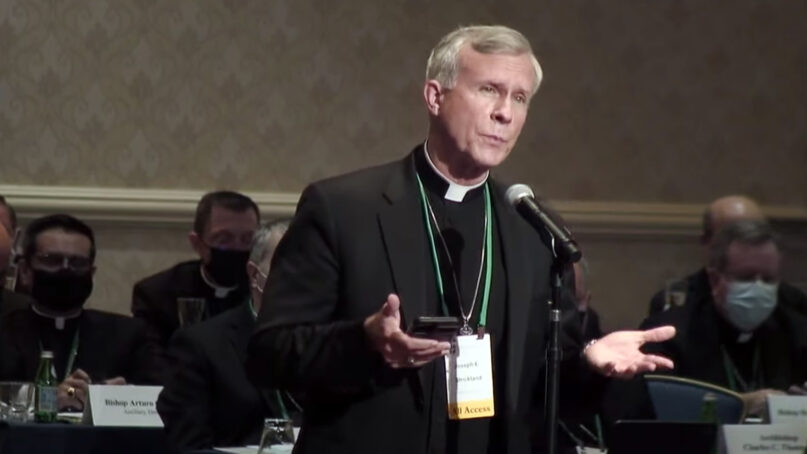(RNS) — By the standards of his predecessors, Pope Francis has been remarkably tolerant of criticism from those lower down in the Catholic hierarchy, putting up with all manner of sniping, bad-faith questioning and outright attacks from right-wing cardinals, bishops and priests. But it turns out there’s a limit.
On Saturday (Nov. 11), the Vatican announced that Francis had removed Joseph E. Strickland as bishop of Tyler, Texas. Although no explanation was given for the move, it’s not hard to figure out.
Once upon a time, by all accounts, Strickland was a genial prelate well-liked inside and outside his diocese. But according to the Rev. Timothy Kelly, pastor at one of Tyler’s churches, that changed seven years ago.
“[C]harity was replaced in this diocese,” wrote Kelly on the website Reason & Theology in the wake of Strickland’s removal. “Good, decent Catholic people, who had served at the diocese for a generation, were fired without as much as a thank you. Their hurt has never been recognized, nor has any apology ever been made.
“Priests who disagreed with the bishop were intimidated by his supporters. I can personally attest to such phone calls from prominent friends of the bishop.”
Meanwhile, Strickland’s criticism of Francis grew ever more harsh. In May, to give just one example, he wrote on X, “I believe Pope Francis is the Pope but it is time for me to say that I reject his program of undermining the Deposit of Faith,” a term that essentially refers to the whole of Catholic thought and belief.
Last summer, the Vatican appointed two bishops to evaluate Strickland’s administration of his diocese. Their assessment was not positive, according to unnamed Vatican sources cited in The Pillar, an online Catholic news site. In September, more reports had it that Strickland was likely to be asked to resign, but that if he refused, Francis was unlikely to remove him.
Then, on Oct. 31, at a meeting in Rome of the anti-Francis Rome Life Forum, Strickland upped the ante by reading aloud from a letter he said had been sent to him by a friend.
“You cannot, indeed, you must not go to Rome and play nicely … although playing nicely might ensure you are not removed,” the letter declared. “Would you now allow this one who has pushed aside the true Pope and has attempted to sit on a chair that is not his define what the Church is to be?”
By promoting the claim that Francis is not the true pope — that he “has attempted to sit in a chair that is not his” — Strickland seemed to be putting aside his former acknowledgment that “Pope Francis is the Pope” and advocating what’s known as sedevacantism (in English: “empty-chair-ism”). That’s a schismatic position that under canon law earns its adherents automatic excommunication.
At that point, Francis effectively had no choice but to remove from office a man evidently determined to become an ecclesiastical martyr.
Compared to, say, Cardinal Raymond Burke, Strickland appears less a leader of the anti-Francis forces then a willing tool of others — a useful idiot, in anti-Communist parlance. As Father Kelly wrote, “He has been manipulated and used by ruthless men, both laity and priests of this diocese, whose goal was to use the diocese and the bishop to push their extremist ideological agenda.”
Unsurprisingly, Strickland’s removal has been decried by such outspoken anti-Francis prelates as Bishop Carlo Maria Viganò, who called it “a cowardly form of authoritarianism,” and Bishop Athanasius Schneider, who called it “a black day for the Catholic Church of our day.”
But it may be presumed that they will rail with impunity so long as they stay this side of sedevacantism.






